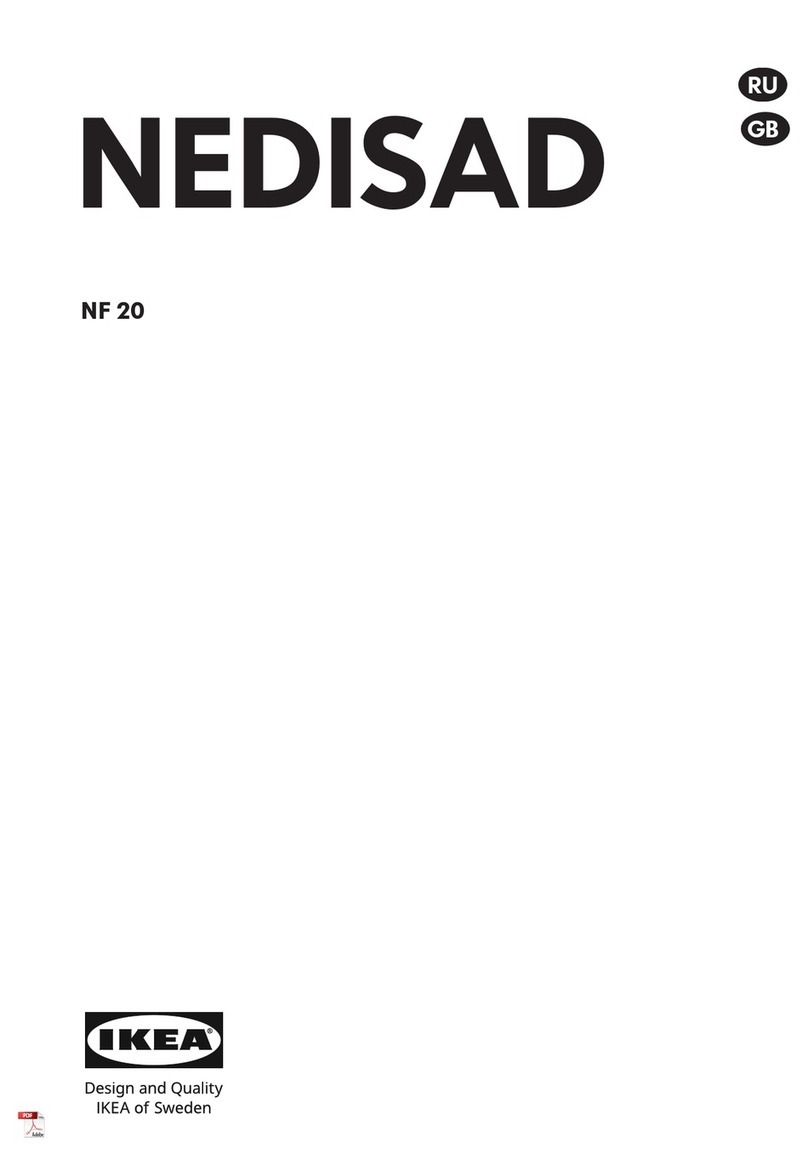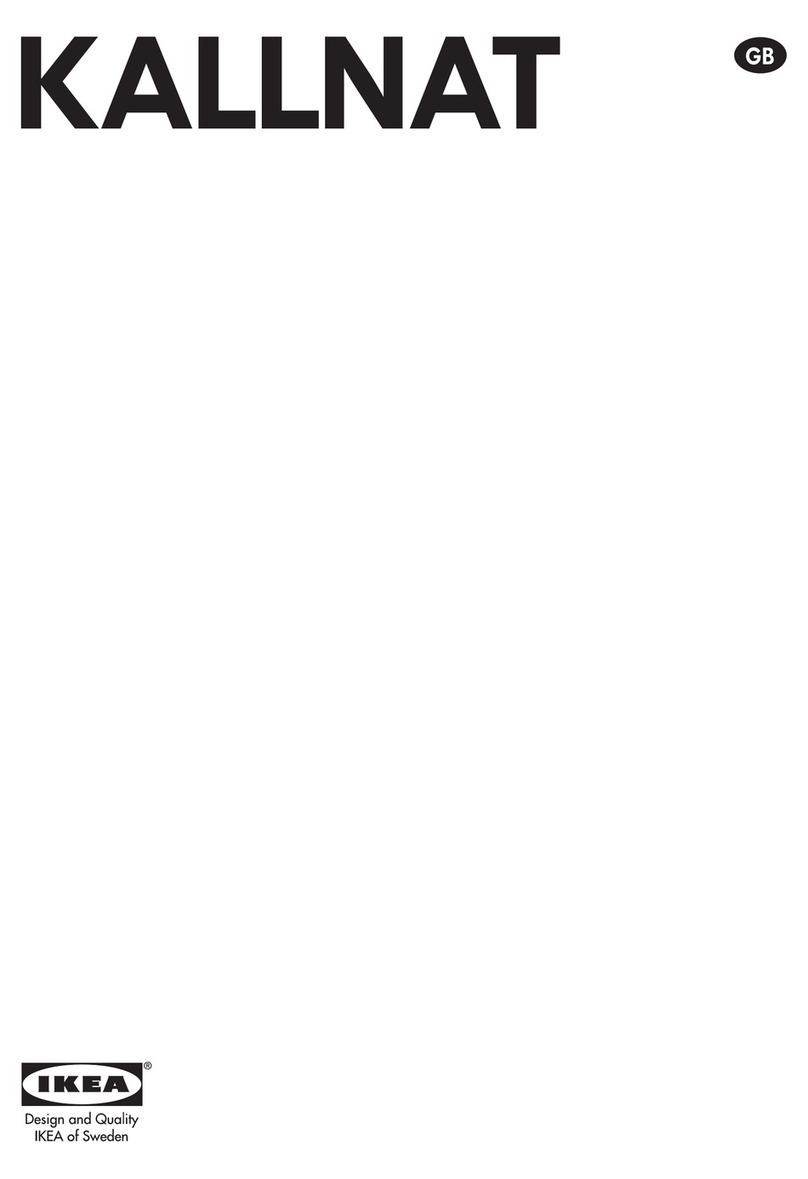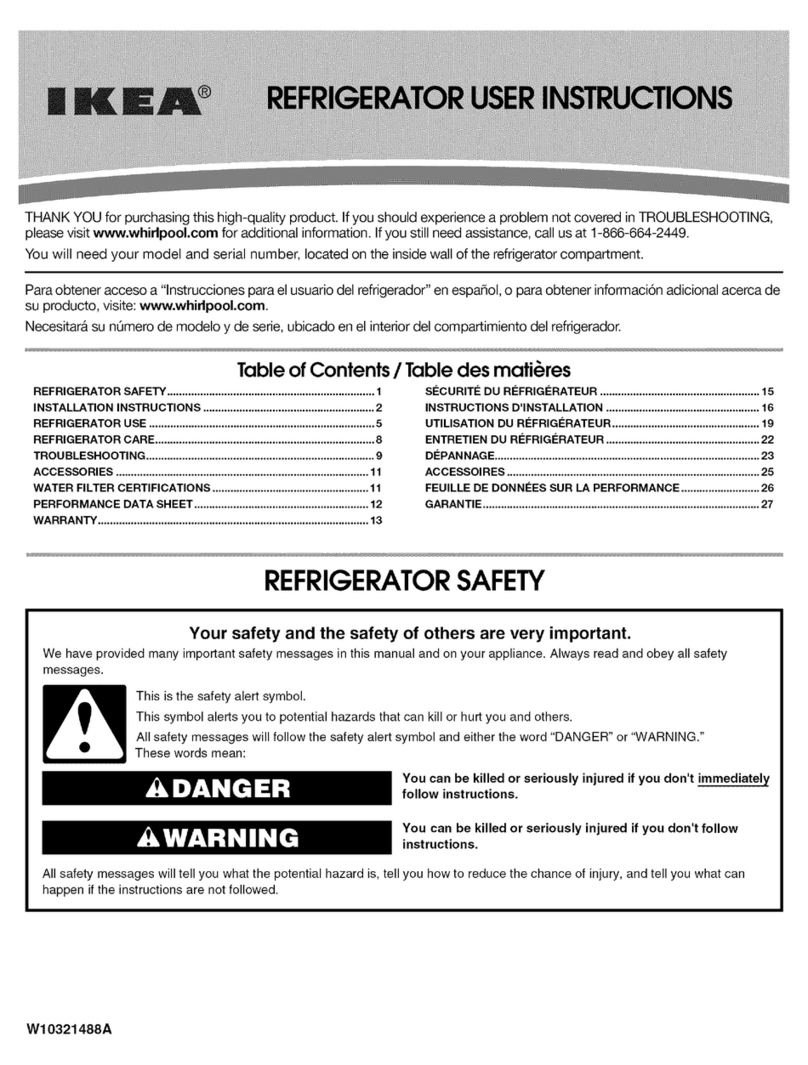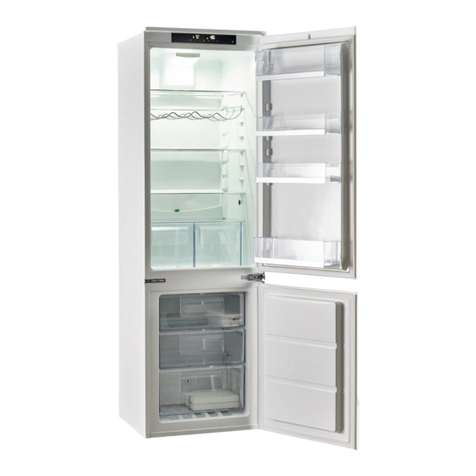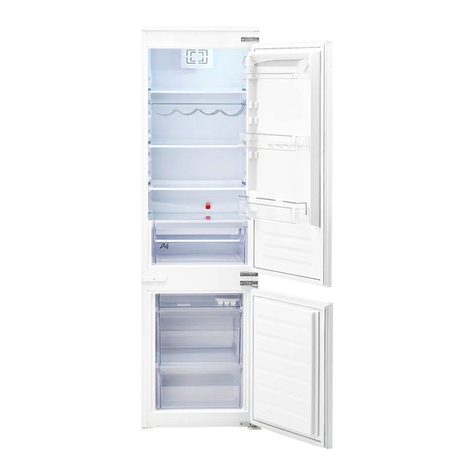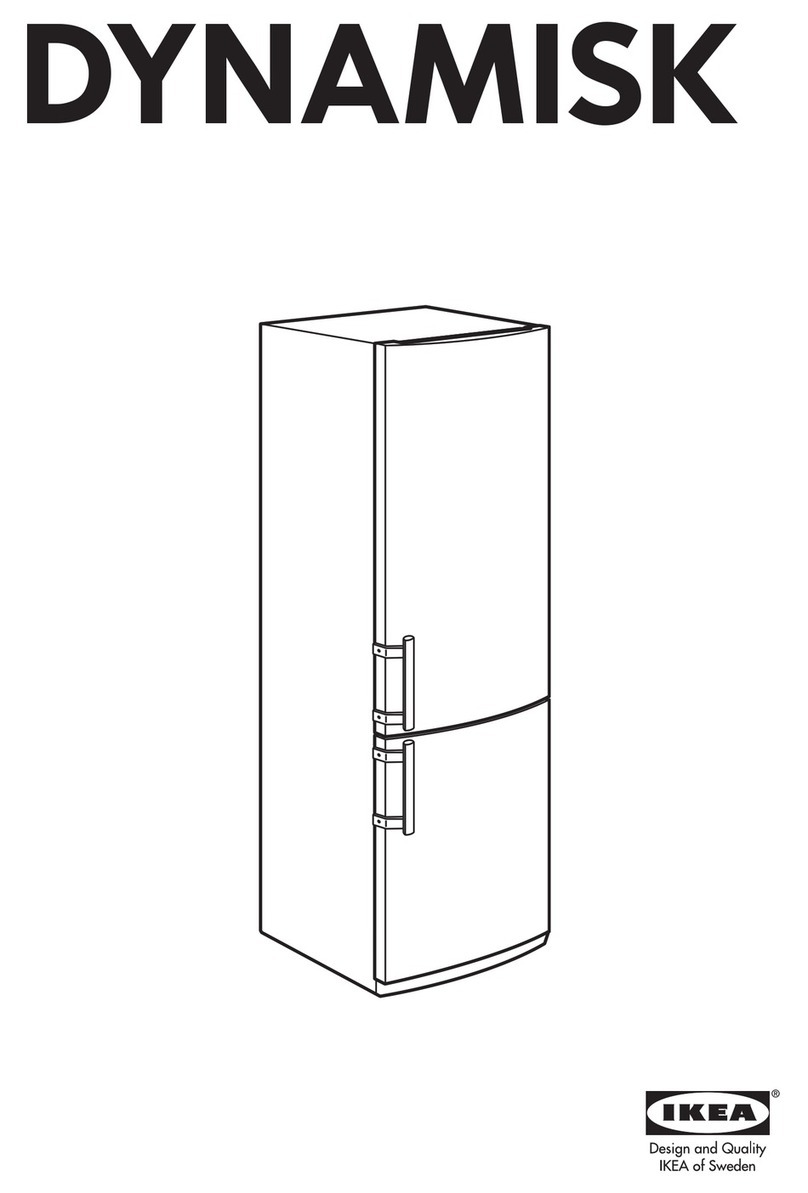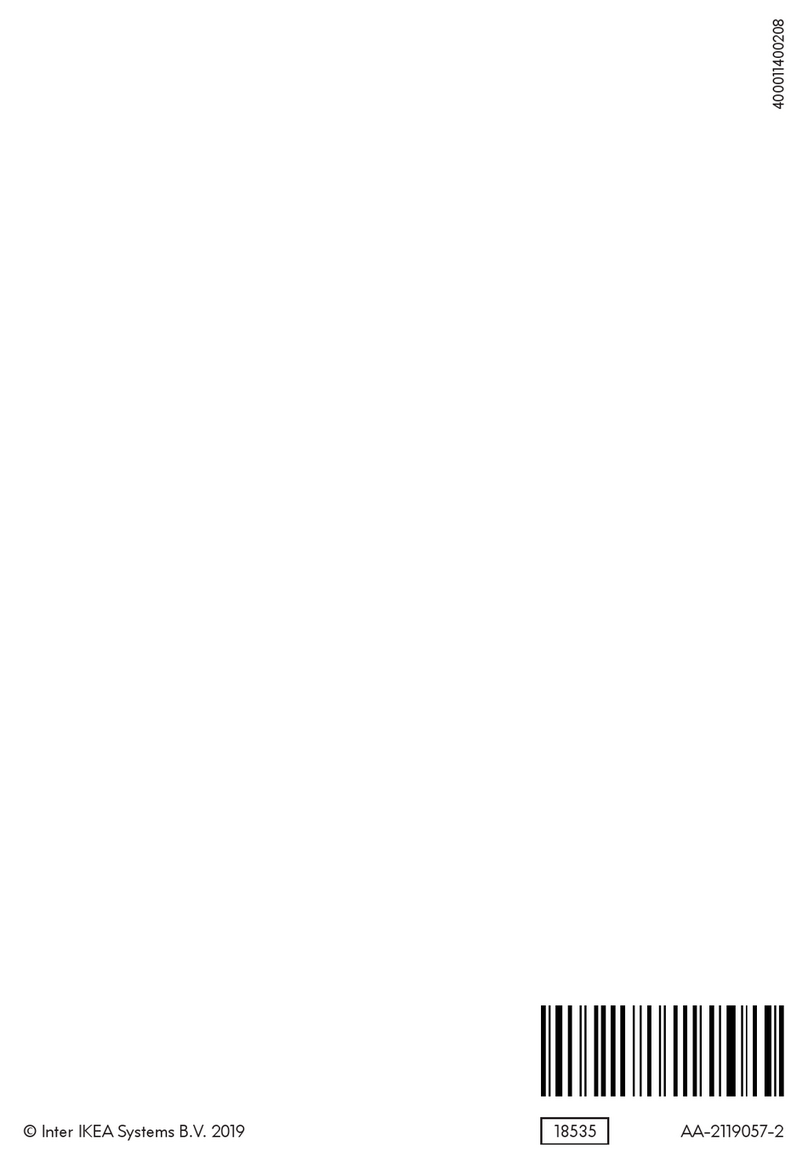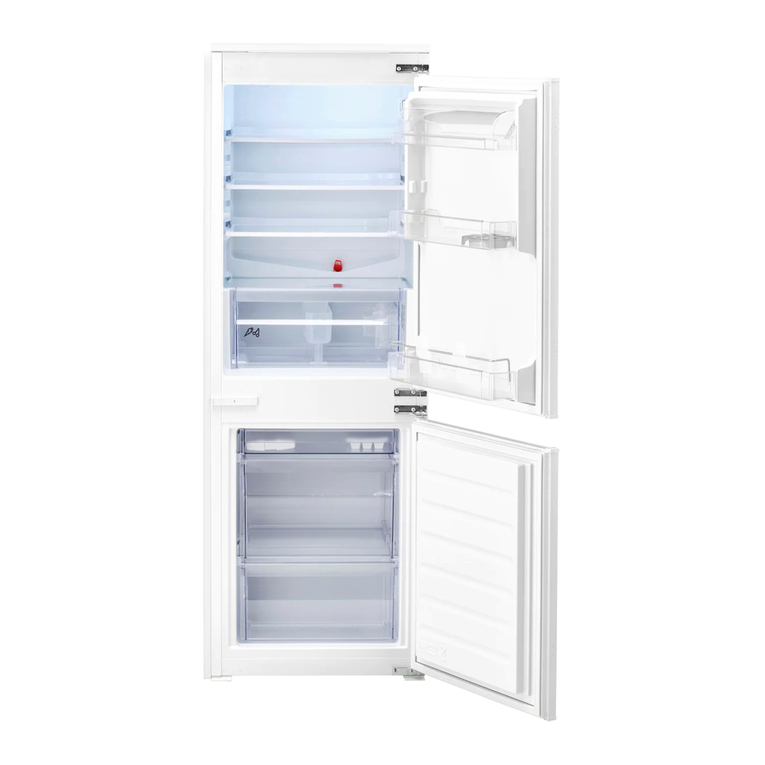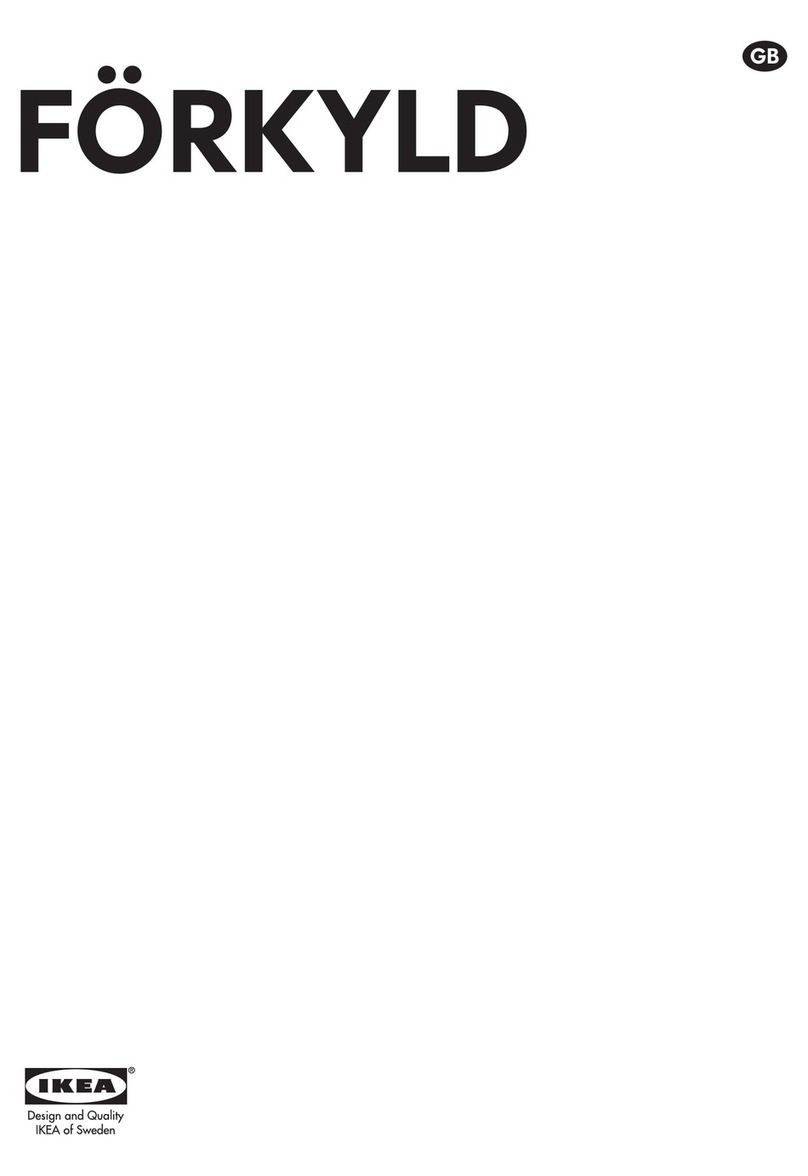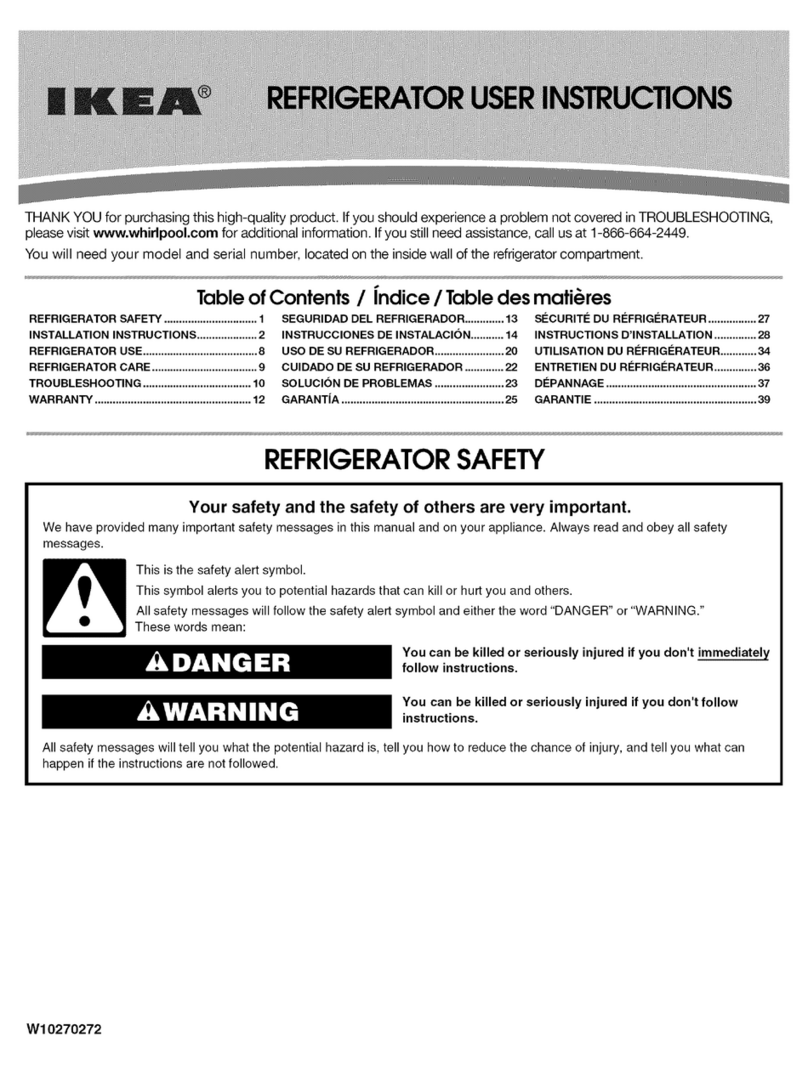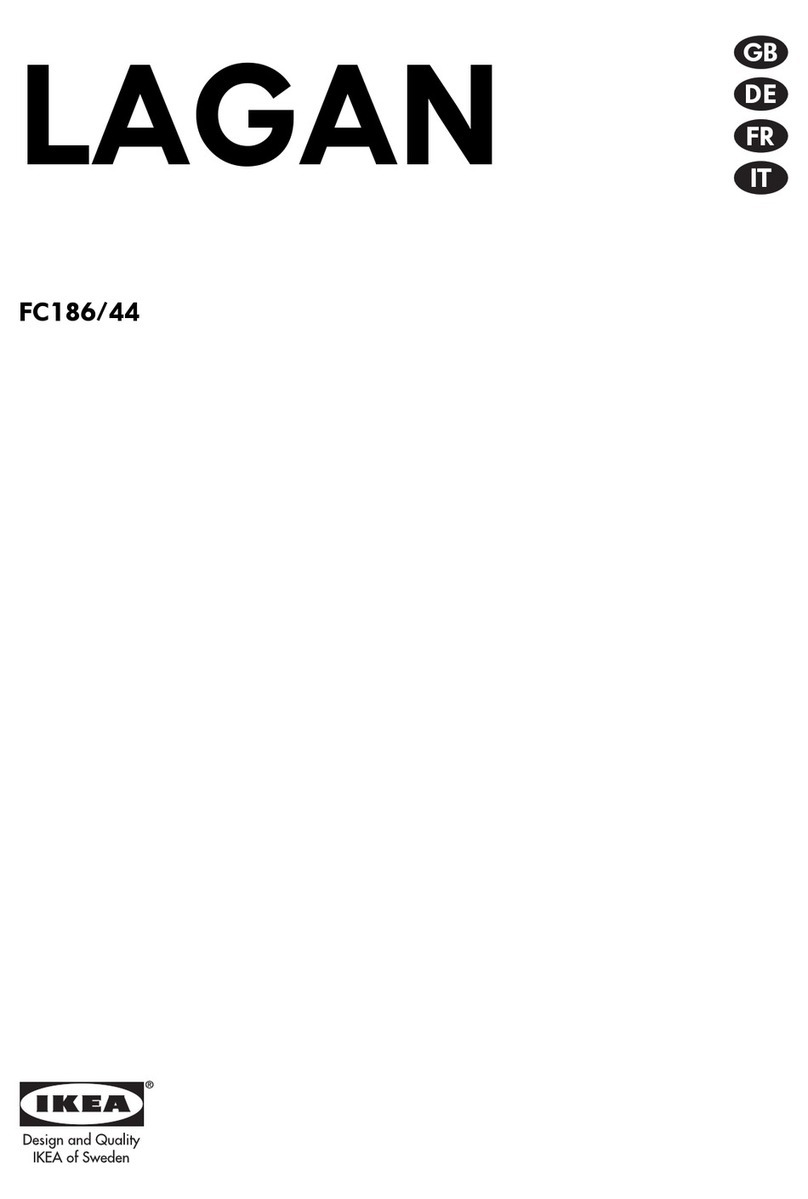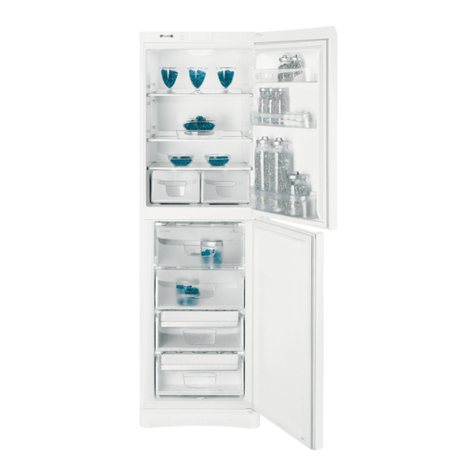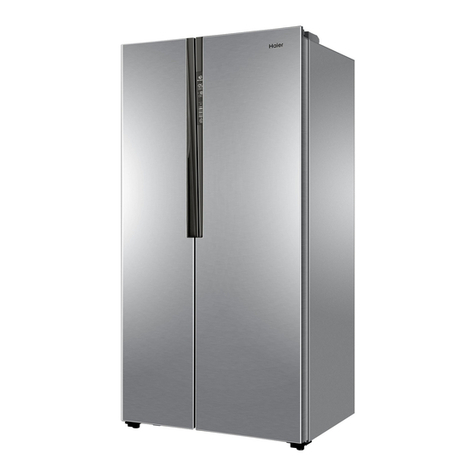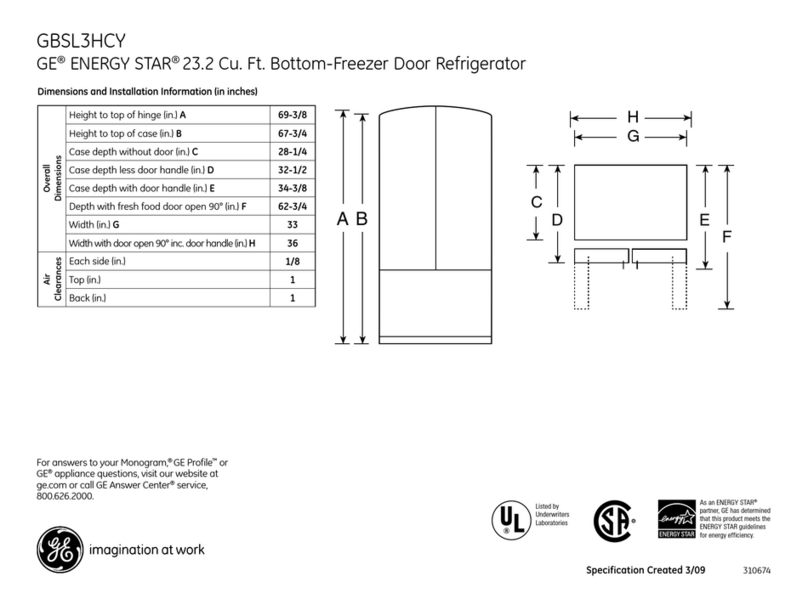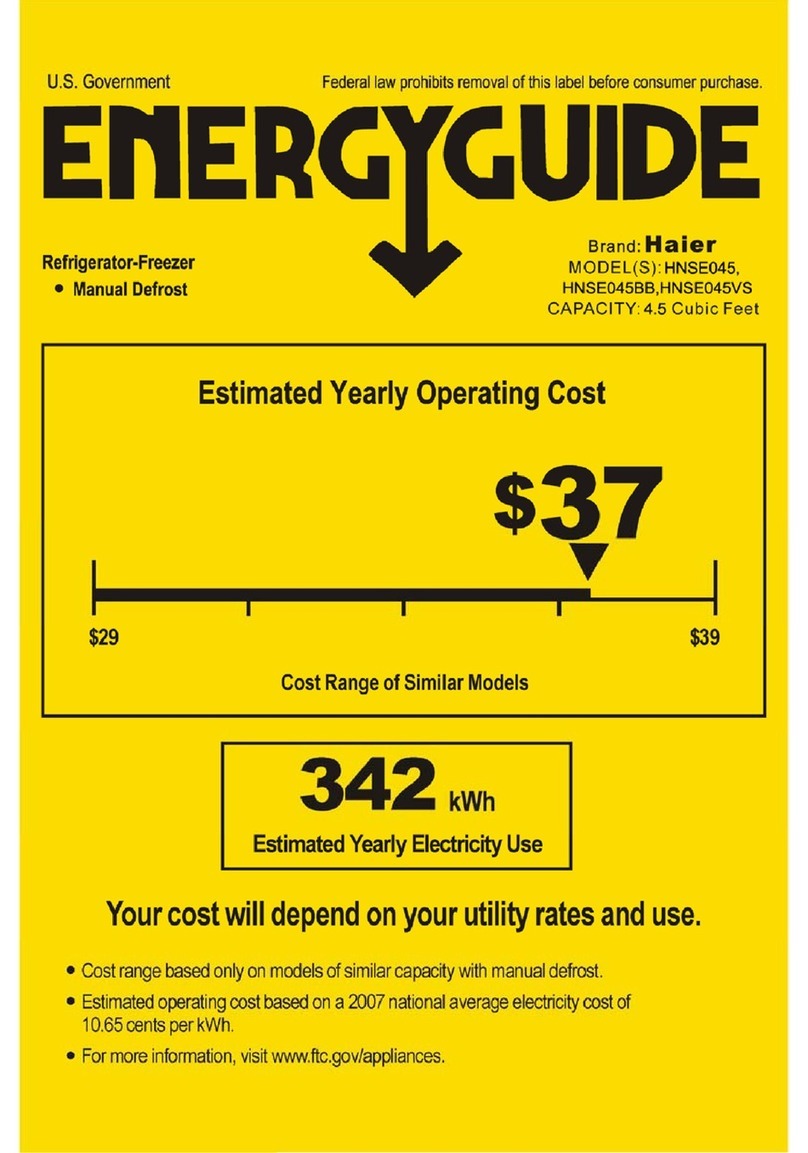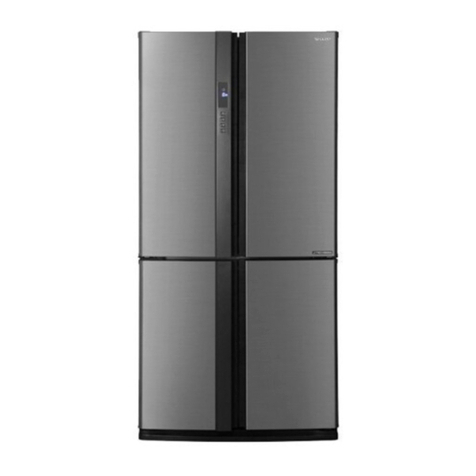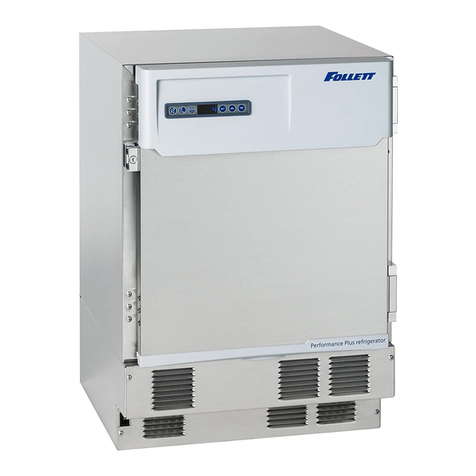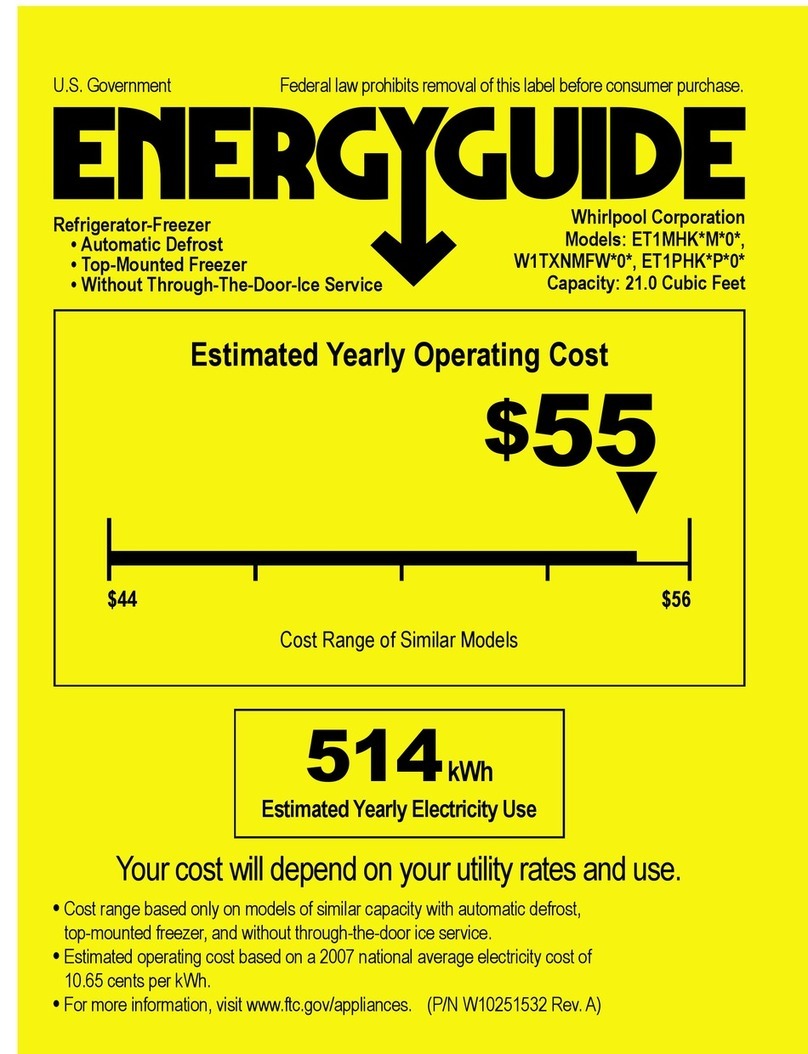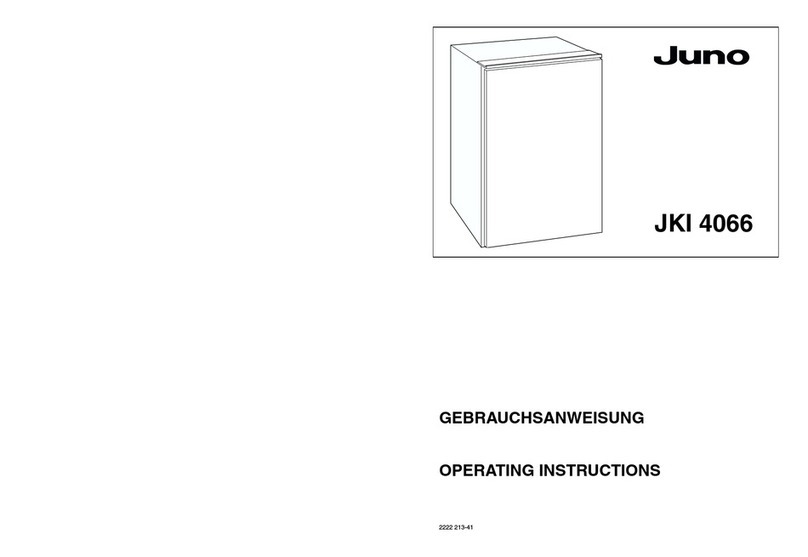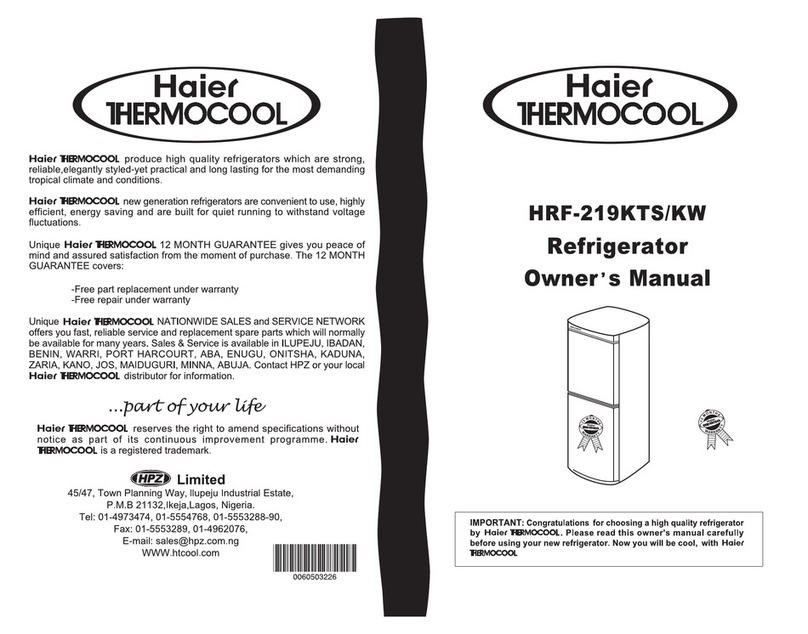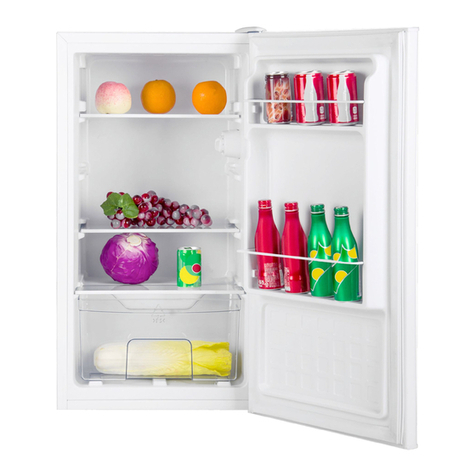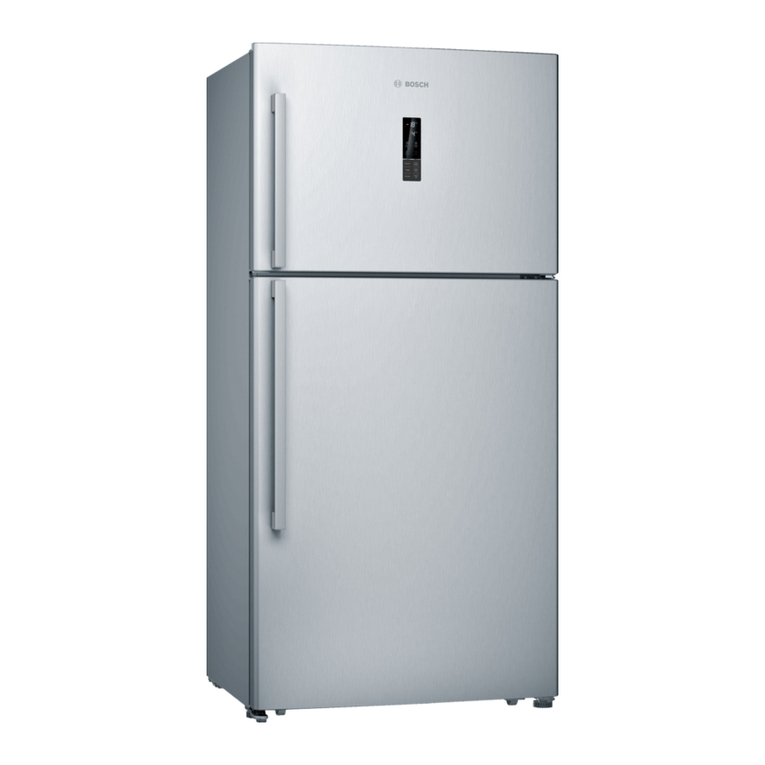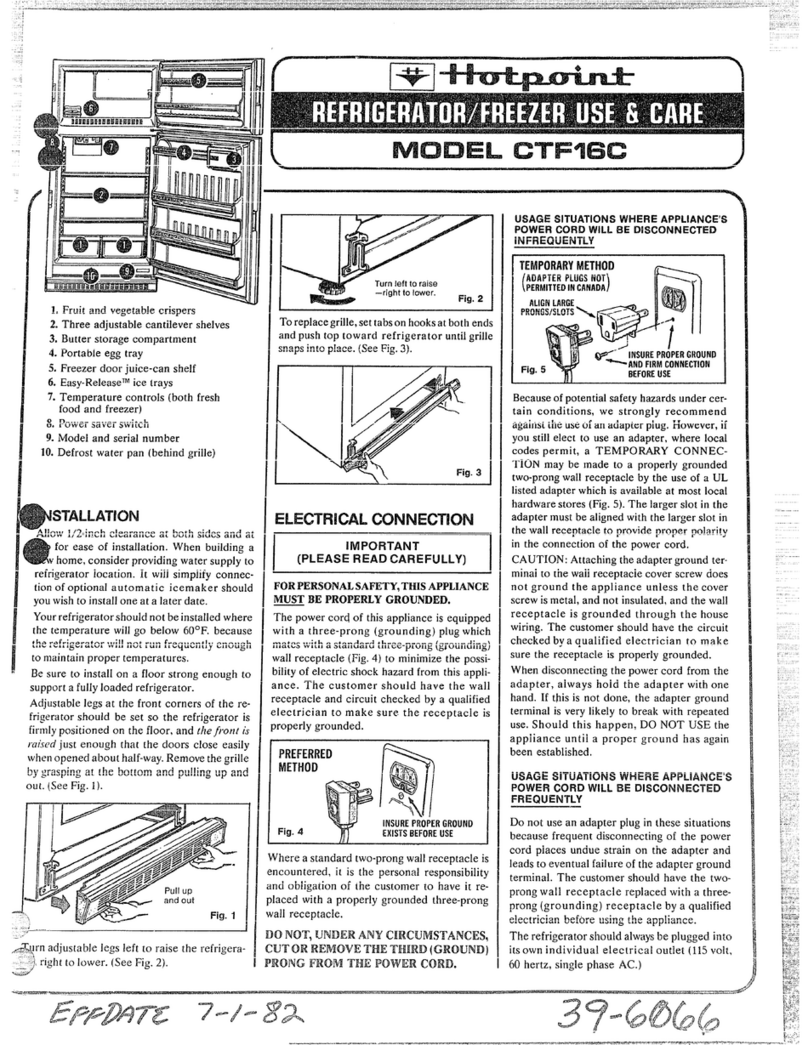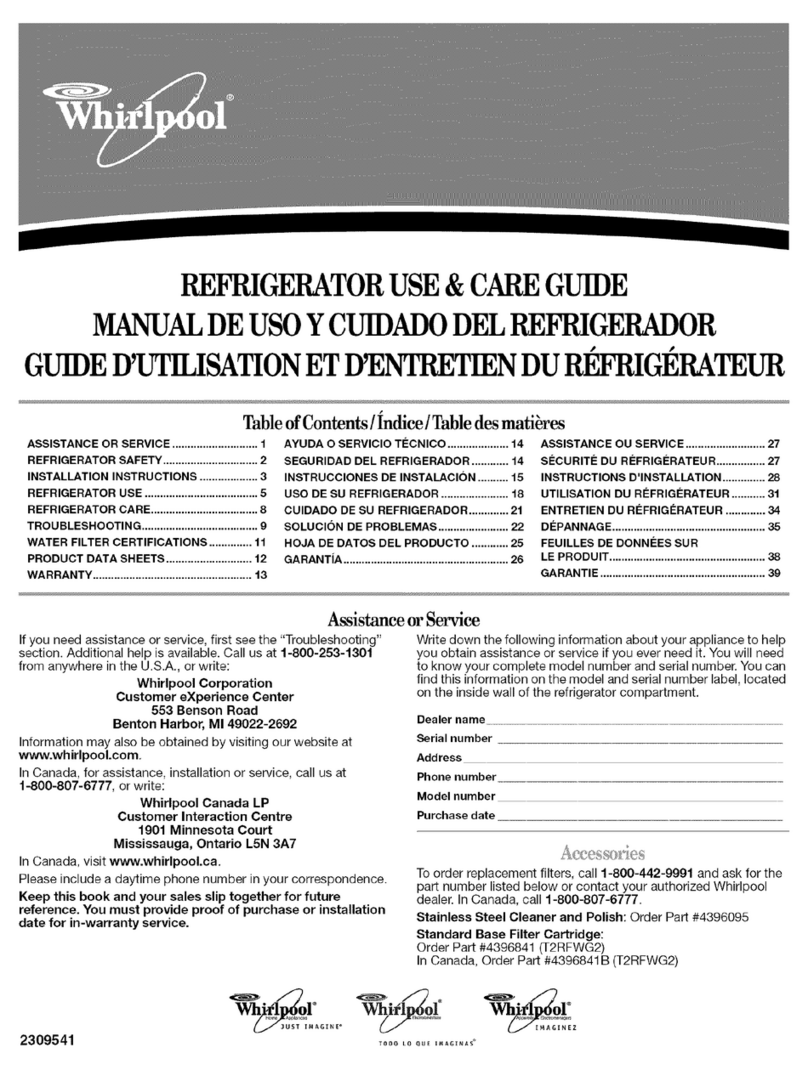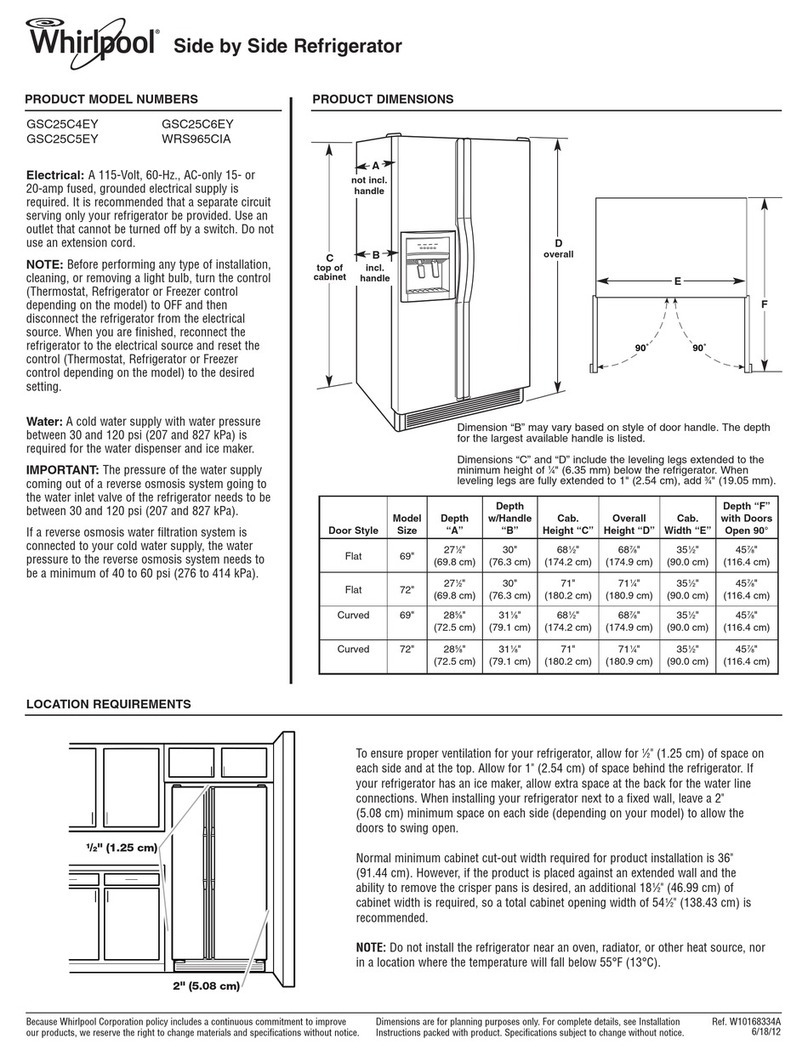IKEA VINDÅS User manual

VINDÅS en


ENGLISH 5


ENGLISH 5
Contents
Safety Information
Please review the following information. Failure
to observe this information may cause injuries
or material damage. Otherwise, all warranty and
reliability
commitments will become invalid.
Original Spare parts will be provided for 10 years,
following the product purchasing date.
Intended use
This product is intended to be used:
• indoors and in closed areas such as homes;
• in closed working environments such as stores
and offices;
• in closed accommodation areas such as farm
houses, hotels, pensions.
• it should not be used outdoors.
General safety
• When you want to dispose/scrap the product,
we recommend you to consult the authorized
service in order to learn the required information
and authorized bodies.
• Consult your authorized service for all your
questions and problems related to the refrigera-
tor. Do not intervene or let someone intervene to
the refrigerator without notifying the authorised
services.
• For products with a freezer compartment; Do
not eat cone ice cream and ice cubes imme-
diately after you take them out of the freezer
compartment! (This may cause frostbite in your
mouth.)
• For products with a freezer compartment: Do
not put bottled and canned liquid beverages in
the freezer compartment. Otherwise, these may
burst.
• Do not touch frozen food by hand; they may
stick to your hand.
• Unplug your refrigerator before cleaning or
defrosting.
• Vapor and vaporized cleaning materials should
never be used in cleaning and defrosting
processes of your refrigerator. In such cases, the
vapor may get in contact with the electrical parts
and cause short circuit or electric shock.
• Never use the parts on your refrigerator such
as the door as a means of support or step.
• Do not use electrical devices inside the
refrigerator.
• Do not damage the parts, where the
refrigerant is circulating, with drilling or cutting
tools. The refrigerant that might blow out
when the gas channels of the evaporator, pipe
extensions or surface coatings are punctured
causes skin irritations and eye injuries.
• Do not cover or block the ventilation holes on
your refrigerator with any material.
• Electrical devices must be repaired by only
authorised persons. Repairs performed by
incompetent persons create a risk for the user.
• Never store spray cans containing flammable
and explosive substances in the refrigerator.
• In case of any failure or during a maintenance
or repair work, disconnect your refrigerator’s
mains supply by either turning off the relevant
fuse or unplugging your appliance.
• Do not pull by the cable when pulling off the
plug.
• Place the beverage with higher proofs tightly
closed and vertically.
• Do not use mechanical devices
or other means to accelerate the defrosting
process, other than those recommended by the
manufacturer.
• This product is not intended to be used
by persons with physical, sensory or mental
disorders or unlearned or inexperienced people
(including children) unless they are attended by
a person who will be responsible for their safety
or who will instruct them accordingly for use of
the product.
• Do not operate a damaged refrigerator.
Consult with the service agent if you have any
concerns.
Safety Information
Environmental concerns
Product description
First use
Tehnical data
Installation
Preparation
Daily use
Maintenance and cleaning
What to do if ...
IKEA GUARANTEE
5
6
7
8
8
9
10
10
12
13
17

ENGLISH 6
• Electrical safety of your refrigerator shall be
guaranteed only if the earth system in your
house complies with standards.
• Exposing the product to rain, snow, sun and
wind is dangerous with respect to electrical
safety.
• Contact authorized service when there is a
power cable damage to avoid danger.
• Never plug the refrigerator into the wall outlet
during installation. Otherwise, risk of death or
serious injury may arise
• This refrigerator is intended for only storing
food items. It must not be used for any other
purpose.
• Label of technical specifications is located on
the left wall inside the refrigerator.
• Never connect your refrigerator to elec-
tricity-saving systems; they may damage the
refrigerator.
• If there is a blue light on the refrigerator, do
not look at the blue light with optical tools.
• For manually controlled refrigerators, wait for
at least 5 minutes to start the refrigerator after
power failure.
• This operation manual should be handed in to
the new owner of the product when it is given to
others.
• Avoid causing damage on power cable when
transporting the refrigerator. Bending cable may
cause fire. Never place heavy objects on power
cable.
• Do not touch the plug with wet hands when
plugging the product.
• Avoid causing damage on power cable when
transporting the refrigerator. Bending cable may
cause fire. Never place heavy objects on power
cable.
• Do not touch the plug with wet hands when
plugging the product.
• Do not plug the refrigerator if the wall outlet
is loose.
• Water should not be sprayed on inner or outer
parts of the product for safety purposes.
• Do not spray substances containing
inflammable gases such as propane gas near the
refrigerator to avoid fire and explosion risk.
• Never place containers filled with water on top
of the refrigerator; in the event of spillages, this
may cause electric shock or fire.
• Do not overload the refrigerator with food. If
overloaded, the food items may fall down and
hurt you and damage refrigerator when you
open the door.
• Never place objects on top of the refrigerator;
otherwise, these objects may fall down when you
open or close the refrigerator’s door.
• As they require a precise temperature,
vaccines, heat-sensitive medicine and scientific
materials and etc. should not be kept in the
refrigerator.
• If not to be used for a long time, refrigerator
should be unplugged. A possible problem in
power cable may cause fire.
• The plug’s tip should be cleaned regularly with
a dry cloth; otherwise, it may cause fire.
• Refrigerator may move if adjustable legs
are not properly secured on the floor. Properly
securing adjustable legs on the floor can prevent
the refrigerator to move.
• When carrying the refrigerator, do not hold it
from door handle. Otherwise, it may be snapped.
• When you have to place your product next to
another refrigerator or freezer, the distance be-
tween devices should be at least 8cm. Otherwise,
adjacent side walls may be humidified.
Environmental concerns
Compliance with the WEEE Regulation and
Disposing of the Waste Product
The symbol on the product or on packaging
indicates that this product may not be treated
as household waste. Instead it shall be handed
over to the applicable collection point for the
recycling of electrical and electronic equipment. By
ensuring this product is disposed of correctly, you
will help prevent potential negative consequences
for the environment and human health, which
could otherwise be caused by inappropriate
waste handling of this product. For more detailed
information about recycling of this product, please
contact your local city office, you household waste
disposal service or the shop where you purchased
the product.
Package information
Packaging materials of the product are manu-
factured from recyclable materials in accordance
with our National Environment Regulations. Do not
dispose of the packaging materials together with
the domestic or other wastes. Take them to the
packaging material collection points designated by
the local authorities.

ENGLISH 7
Do not forget...
Any recycled substance is an indispensable
matter for nature and our national asset wealth.
If you want to contribute to the reevaluation of
the packaging materials, you can consult to your
environmentalist organizations or the municipali-
ties where you are located.
HCA warning
If your product’s cooling system contains R600a:
This gas is flammable. Therefore, pay attention
to not damaging the cooling system and piping
during usage and transportation. In the event of
damage, keep your product away from potential
fire sources that can cause the product catch a fire
and ventilate the room in which the unit is placed.
Type of gas used in the product is stated in
the type label which is on the left wall inside the
refrigerator.
Never throw the product in fire for disposal.
Things to be done for energy Saving
• Do not put hot food or drinks in your
refrigerator.
• Do not overload your refrigerator so that the
air circulation inside of it is not prevented.
• Do not install your refrigerator under direct
sunlight or near heat emitting appliances such
as ovens, dishwashers or radiators. Keep your
refrigerator at least 30 cm away from heat
emitting sources and at least 5 cm from electrical
ovens.
• Pay attention to keep your food in closed
containers.
• For products with a freezer compartment; You
can store maximum amount of food items in the
freezer when you remove the shelf or drawer of
the freezer.
• Energy consumption value stated for your
refrigerator has been determined by removing
freezer shelf or drawer and under maximum
load. There is no harm to use a shelf or drawer
according to the shapes and size of food to be
frozen.
• Thawing frozen food in fridge compartment
will both provide energy saving and preserve the
food quality.
• Do not leave the doors of your refrigerator
open for a long time.
In case the information which are given in
the user manual are not taken into account,
manufacturer will not assume any liability for this.
Product description
1
2
2
2
3
4
5
6
6
7
8
8
9
10*
1
2
3
4
5
6
7
8
9
10
Setting knob and interior light
Adjustable Cabinet shelves
Cover glass
Salad crispers
Compartment for quickly freezing
Compartments for frozen froods
Adjustable front feet
Shelf for jars
Shelf for bottles
Plunger
* (annexed to the reversibility kit)

ENGLISH 8
First use
Before using your refrigerator, make sure the necessary preparations are made in line with the instructions
in “Safety Information” and “Installation” sections.
After horizontal transportation, product must stand upright for 4 hours before switch on to allow
compressor oil to settle.
Keep the product running without placing any food inside for 12 hours and do not open the door, unless
absolutely necessary.
A sound will be heard when the compressor is engaged. It is normal for the product to make noise even if
the compressor is not running, as luid and gas may be compressed in the cooling system.
It is normal for the front edges of the freezer area to be warm. These areas are designed to warm up in
order to prevent condensation.
Tehnical data
Dimensions (mm) VINDÅS
Height(min-max) 1857
Width 595
Depth 685
Net Volume(l)
Fridge 223
Freezer 120
Defrost system
Fridge auto
Freezer manual
Star Rating 4
Rising Time ( h) 12
Freezing capacity(kg/24h) 5.5
Energy consumption( kwh/Year) 244
Noise level(dba) 38
Energy class E

ENGLISH 9
Installation
Points to be paid attention to when the
relocation of the refrigerator
1. Your refrigerator should be unplugged.Before
transportation of your refrigerator, it should be
emptied and cleaned.
2. Before it is re-packaged, shelves, accessories,
crisper, etc. inside your refrigerator should be
fixed with adhesive tape and secured against
impacts. Package should be bound with a thick
tape or sound ropes and the transportation rules
on the package should be strictly observed.
3. Original packaging and foam materials should
be kept for future transportations or moving.
Before you start the refrigerator,
Check the following before you start to use your
refrigerator:
1. Clean the interior of the refrigerator as
recommended in the “Maintenance and cleaning”
section.
2. Open the back condenser.
3. Connect the plug of the refrigerator to the wall
socket. When the fridge door is opened, fridge
internal lamp will turn on.
4. When the compressor starts to operate, a
sound will be heard. The liquid and gases sealed
within the refrigeration system may also give rise
to noise, even if the compressor is not running
and this is quite normal.
5. Front edges of the refrigerator may feel warm.
This is normal. These areas are designed to be
warm to avoid condensation.
Electrical connection
Connect your product to a grounded sock-
et which is being protected by a fuse with the
appropriate capacity. Important:
The connection must be in compliance with
national regulations.
• The power plug must be easily accessible after
installation.
• Electrical safety of your refrigerator shall be
guaranteed only if the earth system in your
house complies with standards.
• The voltage stated on the label located at left
inner side of your product should be equal to
your network voltage.
• Extension cables and multi plugs must not be
used for connection.
A damaged power cable must be replaced by a
qualified electrician.
Product must not be operated before it is
repaired! There is the risk of electric shock!
Disposing of the packaging
The packing materials may be dangerous for
children. Keep the packing materials out of the
reach of children or dispose of them by classifying
them in accordance with the waste instructions
stated by your local authorities. Do not throw
away with regular house waste, throw away on
packaging pick up spots designated by the local
authorities.
The packing of your refrigerator is produced
from recyclable materials.
Disposing of your old Refrigerator
Dispose of your old refrigerator without giving
any harm to the environment.
• You may consult your authorized dealer or
waste collection center of your municipality
about the disposal of your refrigerator.
Before disposing of your refrigerator, cut out the
electric plug and, if there are any locks on the door,
make them inoperable in order to protect children
against any danger.
Changing the illumination Lamp
To change the Bulb/LED used for illumination of
your refrigerator, call your Authorized Service.
The lamp(s) used in this appliance is not suitable
for household room illumination. The intended
To make the product ready for use,be careful that
the electrical wiring and plumbing are appropriate
by referring to the information in the user manual.
If not, call a qualified electrician and plumber and
have the necessary arrangements made.
WARNING: The manufacturer is not liable for
damages caused by operations by unauthorized
persons.To avoid shaking, place the product on a
flat surface.
WARNING: During the installation, the power
plug of the product should not be plugged in.
Otherwise, there is a danger of death or serious
injury!
WARNING: If the doorway of the room to where
the product will be placed is so narrow that the
product cannot pass through, pass the product
by turning it to side; otherwise, call an authorized
service.
• Do not expose the product to direct sunlight
and do not store it in humid place.
• Do not install the product where the tempera-
ture drops below 10 °C.

10
ENGLISH
purpose of this lamp is to assist the user to place
foodstuffs in the refrigerator/freezer in a safe and
comfortable way.
The lamps used in this appliance have to
withstand extreme physical conditions such as
temperatures below -20°C.
Adjusting the legs
If your refrigerator is unbalanced;
You can balance your refrigerator by turning its
front legs as illustrated in the figure. The corner
where the leg exists is lowered when you turn in
the direction of black arrow and raised when you
turn in the opposite direction. Taking help from
someone to slightly lift the refrigerator will
facili- tate this process.
Preparation
•Your refrigerator should be installed at least 30
cm away from heat sources such as hobs, ovens,
central heater and stoves and at least 5 cm away
from electrical ovens and should not be located
under direct sunlight
•Original packaging and foam materials should
be kept for future transportations or moving.
•Please make sure that the interior of your
refrigerator is cleaned thoroughly.
•If two refrigerators are to be installed side
by side, there should be at least 5 cm distance
between them.
•The door should not be opened frequently.
•When you operate your refrigerator for the first
time, please observe the following instructions
during the initial 12 hours.
•It must be operated empty without any food
in it.
•Do not unplug your refrigerator. If a power
failure occurs out of your control, please see the
warnings in the “What to do if ...” section.
•The ambient temperature of the room where
you install your refrigerator should at least be
10°C. Operating your refrigerator under cooler
conditions is not recommended with regard to its
efficiency.
Daily use
3
Thermostat setting button
The interior temperature of your refrigerator
changes for the following reasons:
• Seasonal temperatures.
• Frequent opening of the door and leaving the
door open for long periods.
• Food put into the refrigerator without cooling
down to the room temperature.
Warm Cold
Min.
1
2
3 4
Max.

ENGLISH 11
• The location of the refrigerator in the room
(e.g. exposing to sunlight).
• You may adjust the varying interior
temperature due to such reasons by using the
thermostat. Numbers around the thermostat
button indicates the cooling degrees.
• If the ambient temperature is higher than 32°C,
turn the thermostat button to maximum position.
• If the ambient temperature is lower than 25°C,
turn the thermostat button to minimum position.
Defrost
A) Fridge compartment
Fridge compartment performs full-automatic
defrosting.
Water drops and a frosting up to 7-8 mm
can occur on the inner rear wall of the fridge
compartment while your refrigerator cools down.
Such formation is normal as a result of the cooling
system.
The frost formation is defrosted by performing
automatic defrosting with certain intervals thanks
to the automatic defrosting system of the rear wall.
User is not required to scrape the frost or remove
the water drops. Water resulting from the defrost-
ing passes from the water collection groove and
flows into the evaporator through the drain pipe
and evaporates here by itself.
Check regularly to see if the drain pipe is clogged
or not and clear it with the stick in the hole when
necessary.
B) Freezer compartment
Deep freezer compartment does not perform
automatic defrosting in order to prevent decaying
of the frozen food. Defrosting is very
straightforward and without mess, thanks to a
special defrost collection basin. Defrost twice a year
or when a frost layer of around 7 (1/4”) mm has
formed. To start the defrosting procedure, switch
off the appliance at the socket outlet and pull out
the mains plug. All food should be wrapped
in several layers of newspaper and stored in a cool
place (e.g. fridge or larder).
Containers of warm water may be placed
carefully in the freezer to speed up the defrosting.
Do not use pointed or sharpedged objects, such as
knives or forks to remove the frost. Never use hair
dryers, electrical heaters or other such electrical
appliances for defrosting.
Sponge out the defrost water collected in the
bottom of the freezer compartment. After
defrosting, dry the interior thoroughly. Insert
the plug into the wall socket and switch on the
electricity supply.
Recommendations for preservation
of frozen food
Prepacked commercially frozen food should be
stored in accordance with the frozen food
manufacturer’s instructions for a ( 4 star)
frozen food storage compartment.
• To ensure that the high quality achieved by
the frozen food manufacturer and the food
retailer is maintained, the following should be
remembered:
1. Put packages in the freezer as quickly as
possible after purchase.
2. Ensure that contents are labeled and dated.
3. Do not exceed “Use By”, “Best Before” dates on
the packaging.

ENGLISH 12
Maintenance and cleaning
Never use gasoline, benzene or similar
substances for cleaning purposes.
We recommend that you unplug the appliance
before cleaning.
Never use any sharp abrasive instrument,
soap, household cleaner, detergent and wax polish
for cleaning.
Use lukewarm water to clean the cabinet of
your refrigerator and wipe it dry.
Use a damp cloth wrung out in a solution of
one teaspoon of bicarbonate of soda to one pint of
water to clean the interior and wipe it dry.
Make sure that no water enters the lamp
housing and other electrical items.
Check door seals regularly to ensure they are
clean and free from food particles.
Protection of plastic surfaces
Do not put the liquid oils or oil-cooked meals
in your refrigerator in unsealed containers as they
damage the plastic surfaces of your refrigerator.
In case of spilling or smearing oil on the plastic
surfaces, clean and rinse the relevant part of the
surface at once with warm water.
If your refrigerator is not going to be used
for a long period of time, unplug the power cable,
remove all food, clean it and leave the door ajar.
To remove door racks, remove all the contents
and then simply push the door rack upwards from
the base.
Never use cleaning agents or water that
contain chlorine to clean the outer surfaces and
chromium coated parts of the product. Chlorine
causes corrosion on such metal surfaces.
Recommendations for the fresh
food compartment
• Do not allow the food
to touch the temperture
sensor in fresh food
compartment. To allow the
fresh food compartment
keep its ideal storage
temperature, sensor must
not be hindered by food.
• Do not place hot foods in
the product.
To maintain a correct temperature inside the
appliance, check that the indicator always shows
OK.
If the indicator turns black, the temperature is too
high in this case, increase the thermostat setting
and wait for 12 hours before checking the indicator
again.
When fresh food has been introduced or the
door has been left open for some time, it is
normal for the indicator to turn black.
COLDEST ZONE INSIDE THE REFRIGERATOR
The symbol at the side indicates the coldest
zone in the refrigerator.
The coldest zone is between the glass shelf of
the salad crisper at the bottom of the refrigerator
and the bottom cabinet shelf.
To maintain the temperature in the zone, be
careful not to change the position of the rack.
For optimum temperature adjustment, the
refrigerator is provided with a temperature
indicator to allow you to control the average
temperature in the coldest zone.
You can carry out regular checks to ensure the
temperature in the coldest zone is correct and, if
necessary, adjust the thermostat as indicated in the
user instructions (chapter “Daily use”).
48 2324 02 01

Please review this list before calling the service. It will save your time and money. This list includes frequent
complaints that are not arising from defective workmanship or material usage. Some of the features de-
scribed here may not exist in your product.
Problems Solutions
The refrigerator does
not operate.
• The plug is not inserted into
the socket correctly.
• Insert the plug into the socket
securely.
• The fuse of the socket
which your refrigerator is
connected to or the main
fuse have blown out.
• Check the fuse.
Condensation on
the side wall of the
fridge compartment
(MULTIZONE, COOL
CONTROL and FLEXI
ZONE).
• Door has been opened
frequently.
• Do not open and close the door of
refrigerator frequently.
• Ambient is very humid. • Do not install your refrigerator
into highly humid places.
• Food containing liquid is
stored in open containers.
• Do not store food with liquid
content in open containers.
•Door of the refrigerator
is left open.
• Close the door of the refrigerator.
• Thermostat is set to a very
cold level.
• Set the thermostat to a suitable
level.
Compressor is not
running
• Protective thermic of the
compressor will blow out
during sudden power
failures.
• The refrigerator will start running
approximately after 6 minutes.
• plug-out plug-ins as the
refrigerant pressure in
the cooling system of the
refrigerator has not been
balanced yet.
• Please call the service if the
refrigerator does not startup at
the end of this period.
• The fridge is in defrost
cycle.
• This is normal for a full-
automatically defrosting
refrigerator. Defrosting cycle
occurs periodically.
• The refrigerator is not
plugged into the socket.
• Make sure that the plug is fit into
the socket.
• Temperature settings are
not made correctly.
• Select the suitable temperature
value.
• There is a power outage. • Refrigerator returns to normal
operation when the power
restores.
ENGLISH
What to do if ...
13

• The operation noise
increases when
the refrigerator is
running.
• The operating performance of the refrigerator may change due to the
changes in the ambient temperature. It is normal and not a fault.
The refrigerator is
running frequently or
for a long time.
• New product may be wider than the previous one. Larger
refrigerators operate for a longer period of time.
• The room temperature may
be high.
• It is normal that the product
operates for longer periods in hot
ambient.
• The refrigerator might
be plugged in recently or
might be loaded with food.
• When the refrigerator is plugged
in or loaded with food recently, it
will take longer for it to attain the
set temperature. This is normal.
• Large amounts of hot
food might be put in the
refrigerator recently.
• Do not put hot food into the
refrigerator.
•Doors might be opened
frequently or left open for
a long time.
• >The warm air that has entered
into the refrigerator causes the
refrigerator to run for longer
periods. Do not open the doors
frequently.
•Freezer or fridge
compartment door
might be left open.
• Check if the doors are closed
completely.
• The refrigerator is adjusted
to a very low temperature.
• Adjust the refrigerator
temperature to a warmer degree
and wait until the temperature is
achieved.
• Door seal of the fridge or
freezer may be soiled, worn
out, broken or not properly
seated.
• Clean or replace the seal.
Damaged/broken seal causes the
refrigerator to run for a longer
period of time in order to maintain
the current temperature.
Fridge temperature
is very low while the
freezer temperature is
sufficient.
• The fridge temperature
is adjusted to a very low
value.
•Adjust the freezer temperature to
a warmer degree and check.
Food kept in the fridge
compartment drawers
is frozen.
• The fridge temperature
is adjusted to a very high
value.
• Adjust the fridge temperature to a
lower value and check.
Freezer temperature is
very low while the
fridge temperature is
sufficient.
•The freezer temperature
is adjusted to a very low
value.
• Adjust the fridge temperature to a
lower value and check.
ENGLISH 14

Temperature in the
fridge or freezer is very
low.
• The fridge temperature
is adjusted to a very high
value.
• Fridge compartment temperature setting
has an effect on the temperature of the
freezer. Change the temperatures of
the fridge or freezer and wait until the
relevant compartments attain a sufficient
temperature.
•Doors are opened
frequently or left open for
a long time.
• Do not open the doors frequently.
•Door is open. • Close the door completely.
• The refrigerator is plugged
in or loaded with food
recently.
• This is normal. When the refrigerator is
plugged in or loaded with food recently,
it will take longer for it to attain the set
temperature.
• Large amounts of hot
food might be put in the
refrigerator recently.
• Do not put hot food into the refrigerator.
Vibrations or noise.
• The floor is not level or
stable.
• If the refrigerator rocks when moved
slowly, balance it by adjusting its feet. Also
make sure that the floor is strong enough
to carry the refrigerator, and level.
• The items put onto the
refrigerator may cause
noise.
• Remove the items on top of the
refrigerator.
There are noises
coming from the
refrigerator like liquid
flowing, spraying, etc.
• Liquid and gas flows occur in accordance with the operating principles of your
refrigerator. It is normal and not a fault.
Whistle comes from the
refrigerator.
• Fans are used in order to cool the refrigerator. It is normal and not a fault.
Condensation on
the inner walls of
refrigerator.
• Hot and humid weather increases icing and condensation. It is normal and not
a fault.
•Doors are opened
frequently or left open for
a long time.
• Do not open the doors frequently. Close
them if they are open.
•Door is open. • Close the door completely.
Humidity occurs on
the outside of the
refrigerator or between
the doors.
• There might be humidity in the air; this is quite normal in humid weather. When
the humidity is less, condensation will disappear.
ENGLISH 15

Bad odour inside the
refrigerator.
• No regular cleaning is
performed.
• Clean the inside of the refrigerator regularly
with a sponge, lukewarm water or carbonate
dissolved in water.
• Some containers or
package materials may
cause the smell.
• Use a different container or different brand
packaging material.
• Food is put into the
refrigerator in uncovered
containers.
• Keep the food in closed containers.
Microorganisms spreading out from
uncovered containers can cause unpleasant
odours.
• Remove the foods that have expired best before dates and spoiled from the
refrigerator.
The door is not closing.
• Food packages are
preventing the door from
closing.
• Replace the packages that are obstructing
the door.
• The refrigerator is not
completely even on the
floor.
• Adjust the feet to balance the refrigerator.
• The floor is not level or
strong.
• Make sure that the product is leveled and
capable to carry the refrigerator.
Crispers are stuck. • The food is touching the
ceiling of the drawer.
• Rearrange food in the drawer.
If The Surface Of The
Product Is Hot.
• High temperatures may be observed between the two doors, on the side
panels and at the rear grill while the product is operating. This is normal and
does not require service maintenance!
ENGLISH 16

How long is the IKEA guarantee valid?
purchase of your appliance at IKEA. The original sales receipt, is
required as proof of purchase. If service work is carried out under
guarantee, this will not extend the guarantee period for the
appliance.
Who will execute the service?
IKEA service provider will provide the service through its own
service operations or authorized service partner network.
What does this guarantee cover?
The guarantee covers faults of the appliance, which have been
caused by faulty construction or material faults from the date
of purchase from IKEA. This guarantee applies to domestic use
not covered under this guarantee?” Within the guarantee period,
the costs to remedy the fault e.g. repairs, parts, labour and travel
will be covered, provided that the appliance is accessible for
repair without special expenditure. On these conditions the EU
guidelines (Nr. 99/44/EG) and the respective local regulations are
applicable. Replaced parts become the property of IKEA.
What will IKEA do to correct the problem?
IKEA appointed Service Provider will examine the product and
decide, at its sole discretion, if it is covered under this guarantee.
If considered covered, IKEA Service Provider or its authorized
service partner through its own service operations, will then, at
its sole discretion, either repair the defective product or replace it
with the same or a comparable product.
What is not covered under this guarantee?
• Normal wear and tear.
• Deliberate or negligent damage, damage caused by failure
to observe operating instructions, incorrect installation or by
connection to the wrong voltage, damage caused by chemical
or electrochemical reaction, rust, corrosion or water damage
including but not limited to damage caused by excessive
lime in the water supply, damage caused by abnormal
environmental conditions.
• Consumable parts including batteries and lamps.
• normal use of the appliance, including any scratches and
• Accidental damage caused by foreign objects or substances
soap drawers.
• Damage to the following parts: ceramic glass, accessories,
crockery and cutlery baskets, feed and drainage pipes, seals,
lamps and lamp covers, screens, knobs, casings and parts of
casings. Unless such damages can be proved to have been
caused by production faults.
• Cases where no fault could be found during a technician’s
visit.
• Repairs not carried out by our appointed service providers
and/or an authorized service contractual partner or where
non-original parts have been used.
• Repairs caused by installation which is faulty or not according
• The use of the appliance in a non-domestic environment i.e.
professional use.
• Transportation damages. If a customer transports the product
to his home or another address, IKEA is not liable for any
damage that may occur during transport. However, if IKEA
delivers the product to the customer’s delivery address, then
damage to the product that occurs during this delivery will be
covered by IKEA.
• Cost for carrying out the initial installation of the IKEA
appliance.
• However, if an IKEA appointed Service Provider or its
authorized service partner repairs or replaces the appliance
under the terms of this guarantee, the appointed Service
Provider or its authorized service partner will reinstall the
repaired appliance or install the replacement, if necessary.
• This does not apply within Ireland, customer should contact
the local IKEA dedicated after sales line or the appointed
Service Provider for further information.
(just for GB)
These restrictions do not apply to fault-free work carried out by
EU
country.
How country law applies
or exceed all the local legal demands. However these conditions
do not limit in any way consumer rights described in the local
legislation.
Area of validity
For appliances which are purchased in one EU country and
taken to another EU country, the services will be provided in
the framework of the guarantee conditions normal in the new
country.
An obligation to carry out services in the framework of the
guarantee exists only if the appliance complies and is installed in
accordance with:
- guarantee claim is made;
- the Assembly Instructions and User Manual Safety
Information.
The dedicated AFTER SALES for IKEA appliances
Please don’t hesitate to contact IKEA appointed Authorized
Service Centre to:
• make a service request under this guarantee;
• the dedicated IKEA kitchen furniture;
•
To ensure that we provide you with the best assistance, please
read carefully the Assembly Instructions and/or the User Manual
before contacting us.
How to reach us if you need our service
Please refer to the last page
of this manual for the full list
of IKEA appointed Authorized
Service Centre and relative
national phone numbers.
In order to provide you a quicker service, we recommend
Always refer to the numbers listed in the booklet of the
always refer to the IKEA article number (8 digit code) and
10 digit service number placed on the rating plate of
your appliance.
SAVE THE SALES RECEIPT!
It is your proof of purchase and required for the guarantee
to apply. The sales receipt also reports the IKEA name and
article number (8 digit code) for each of the appliances you
have purchased.
Do you need extra help?
For any additional questions not related to After Sales of your
appliances please contact your nearest IKEA store call centre.
We recommend you read the appliance documentation carefully
before contacting us.
ENGLISH 17
IKEA GUARANTEE



AA-2408347-24578339077_AB
Country Phone Number Call Fee Opening time
België Lokaal nummer Ma.-Vrij.09.00-17.00
Belgique Nombre local Lun.-Ven. 09.00-17.00
България 0800 45800 Безплатен телефонен номер Пон-Нед 9:00-20:00
Česká republika +420 227 272 613 lokální číslo7 dní v týdnu 8:00-17:00
Danmark 70 15 09 09
https://serviceinfo.se/onsite/ikea Landstakst man. - fre. 09.00 - 20.00
lør. - søn. 09.00 - 18.00
Deutschland 06102 86 86 891 Regional Number Mo.-Fr. 8.00-18.00
3,726,366,525 Vastavalt operaatori tariile Es-Re 9:00-17:30
3,724,427,231 Vastavalt operaatori tariile Es-Re 9:00-18:00
7,344,299 Vastavalt operaatori tariile Es-Re 9:00-18:00
6,512,222 Vastavalt operaatori tariile Es-Re 9:00-17:00
Espanã 932 514 201 Numero local Lunes a Viernes: 9:00 – 20:00
Ελλάδα +30 2510 392 511/512
Με χρέωση σύμφωνα με τη
τιμολογιακή πολιτική του
τηλεπικοινωνιακού παρόχου σας
Δευτ. – Παρ. 09.00 – 17.00
France 09 69 37 71 99 Service gratuit + prix appel Du lundi au vendredi de 9h00 à 19h00.
Nederland 088 - 3425200 Lokaal nummer Ma-Vrij. 09.00-17.00
Norge 815 59590
https://serviceinfo.se/onsite/ikea Lokal takst Mo-Fr: 09.00-15.00
Hrvatska 01 77 100 71 Lokalni poziv
Ponedjeljak - petak od 9:00 - 17:00
Subota od 9:00 - 14:00
Italia02 7040 National Number Dal lunedì al sabato - dalle 08.00 alle 20.00
Ireland 01 862 3411 National Number
Mon – Fri 8.00am – 6.00pm
Sat – Sun 9.00am – 5.00pm
UK Public holidays 9.00am – 5.00pm
Ísland 3,545,202,500 Sveitarfélaga skatta Mán-Sun: 11:00-17:30
Κύπρος (+357) 22 502 502
Με χρέωση σύμφωνα με τη
τιμολογιακή πολιτική του
τηλεπικοινωνιακού παρόχου σας
Δευτ. – Σαβ. 08:00 – 21:00Κυρ. 11:00 – 20:00
Latvija+(371) 67-42-52-32 Saskaņā ar operatora tarifu Pir-Pie 9:00-17:30
8 700 55 595 Pagal operatoriaus tarifa Pir-Pen 9:00-18:00
370 37 330187 Pagal operatoriaus tarifa Pir-Pen 9:00-18:00
Luxembourg 0032 2 303 75 75 Tu appelles la belgique Lundi- Vendredi. 09.00-17.00
Magyarország +36 1 210 92 37 Helyi tarifával hívható Hétfő– Péntek 8:00 - 17:00
Россия 8 800 200 23 56 Федеральная горячая линия
Пн-Пт: 07.00-21.00
Сб-Вс: 08.00-21.00
Праздничные дни: 08.00-17.00
Polska 222 50 14 14 wg taryfy operatora Poniedziałek - Piątek 8:00 - 20:00
Portugal 00351 215551968Chamada local (sem custo adicional)Segunda a Sexta das 9h00 às 18h00
Romania *9010 Numar national taxat standard Luni - Vineri 08:30 - 20:00
Sambata - 08:30 - 17:00
Schweiz Tarif für Anrufe im Bundesgebiet
SuisseTarif des appels nationaux
Svizzera Taria applicata alle chiamate
nazionali
Slovenija 01 309 3701 Lokalni poziv Ponedeljek - petek od 8.00 - 18.00
Slovensko +421 572 909 620 lokálne číslo7 dní v týždni 8:00-17:00
Srbija 0800 800 008 Besplatan poziv Subota odPonedeljak - petak od 9:00 - 17:00
9:00 - 14:00
Suomi 0800 152 152
https://serviceinfo.se/onsite/ikea Local number Mo-Fr: 09.00-16.00
Sverige 775700500
https://serviceinfo.se/onsite/ikea Lokalsamtal (lokal taxa)
mån-fre 8.30 - 20.00
lör-sön 9.30 - 18.00
United Kingdom 0333 207 9710 National Number
Mon – Fri 8.00am – 6.00pm
Sat – Sun 9.00am – 5.00pm
UK Public holidays 9.00am – 5.00pm
Österreich01 26 76 004Local number Mo.-Fr. 8.00-17.00
0 2 303 75 75
Eesti
Lietuva
0848 801 100 Mo-Fri: 8:30 – 19:30
Sa: 8:30 -18:00
Other manuals for VINDÅS
2
Table of contents
Other IKEA Refrigerator manuals
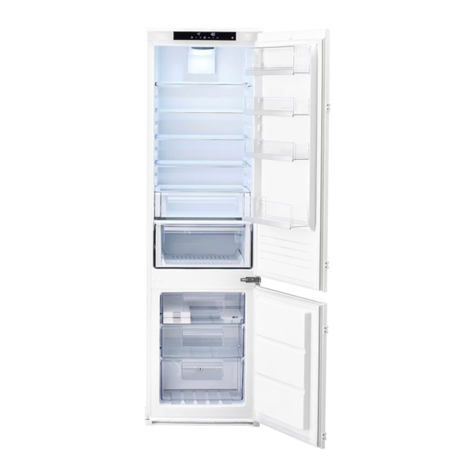
IKEA
IKEA KÖLDGRADER User manual
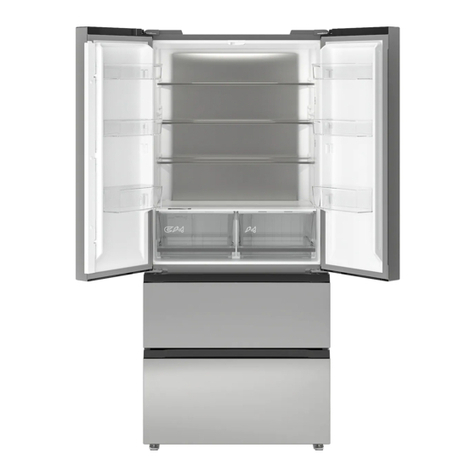
IKEA
IKEA VINTERKALL EN 62552:2020 User manual

IKEA
IKEA KYLIG User manual
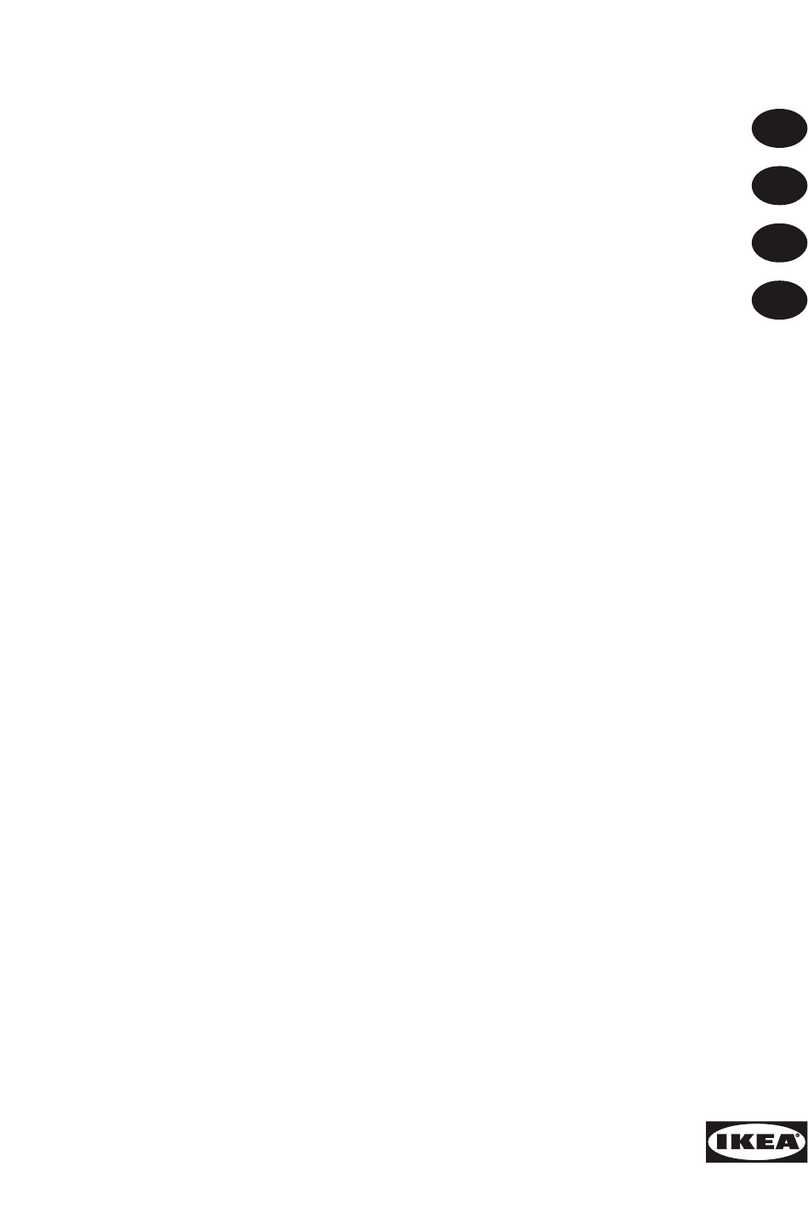
IKEA
IKEA FORSNAS User manual
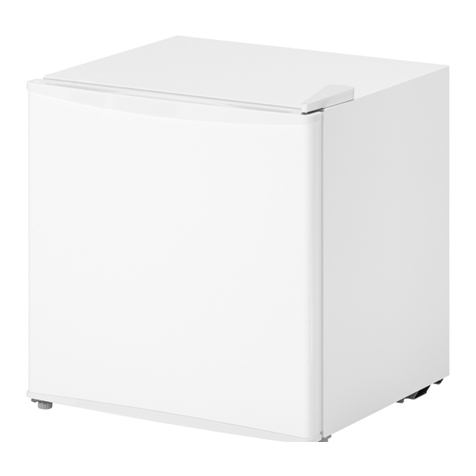
IKEA
IKEA TILLREDA User manual
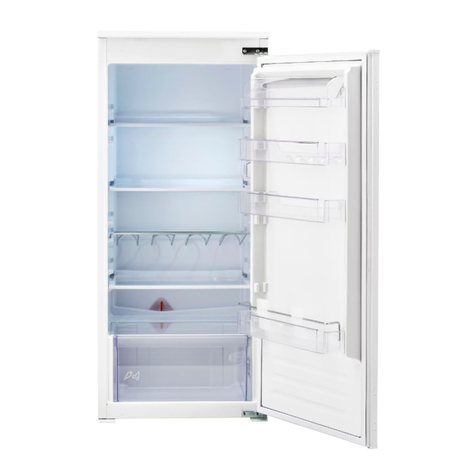
IKEA
IKEA AVKYLD User manual
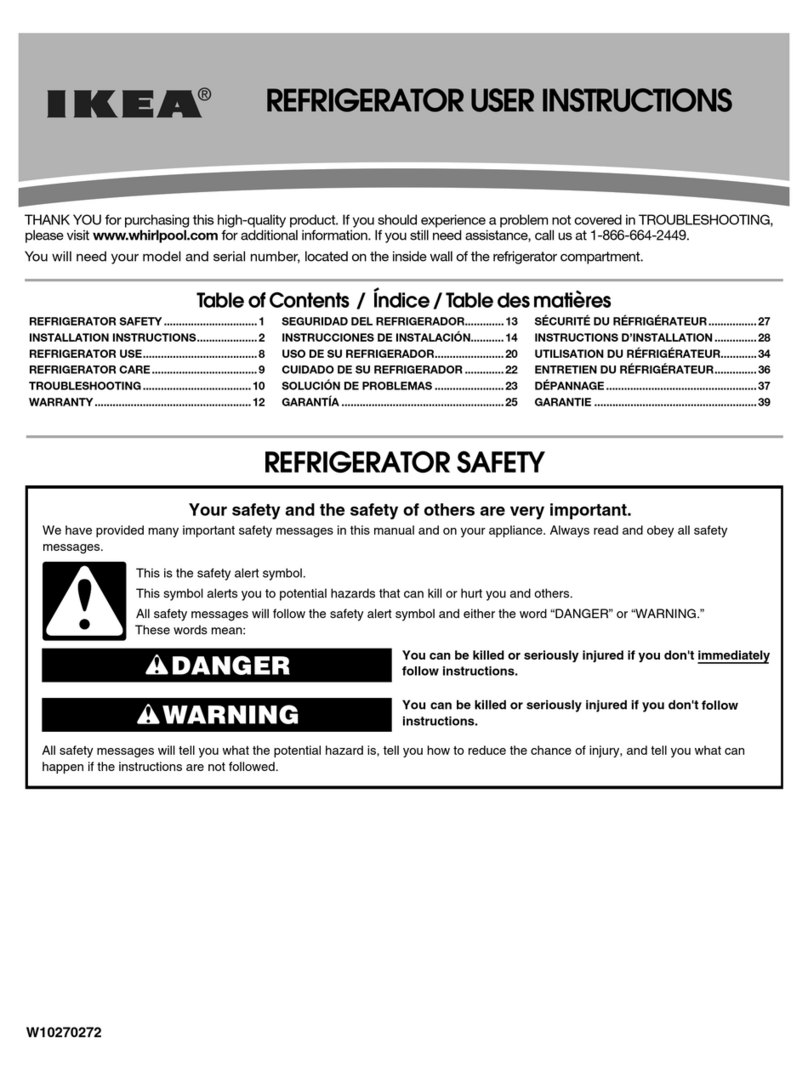
IKEA
IKEA W10270272 User manual

IKEA
IKEA IR8GSMXRS00 User manual
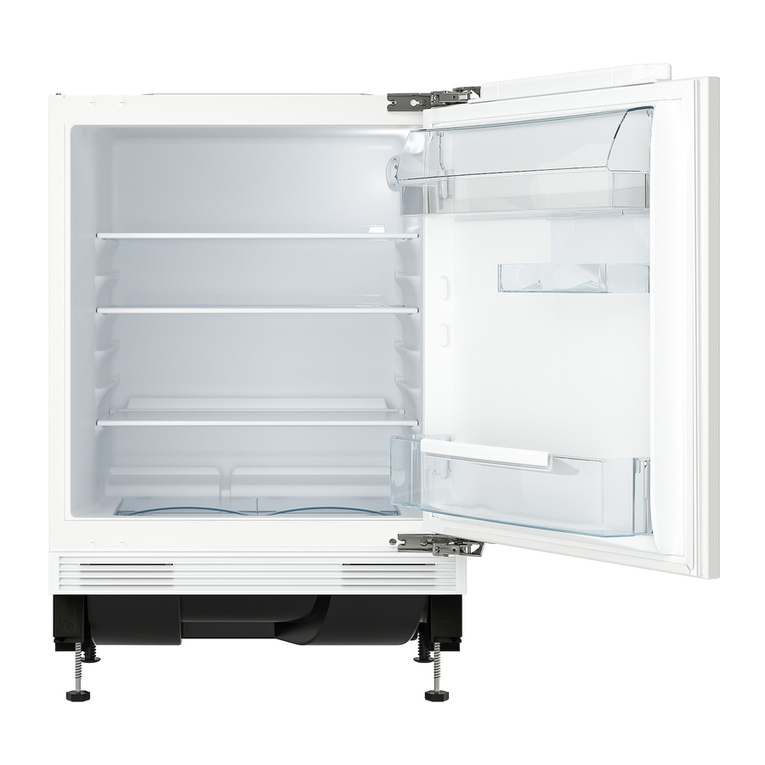
IKEA
IKEA SMAFRUSEN User manual

IKEA
IKEA IK8RXCGMXW00 User manual
